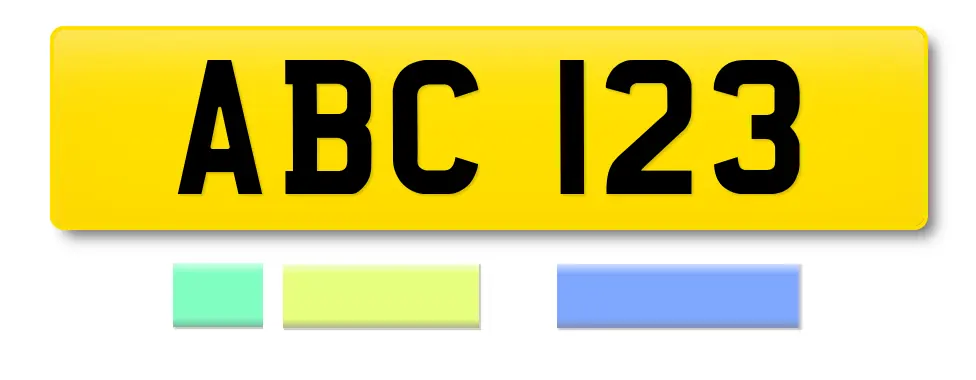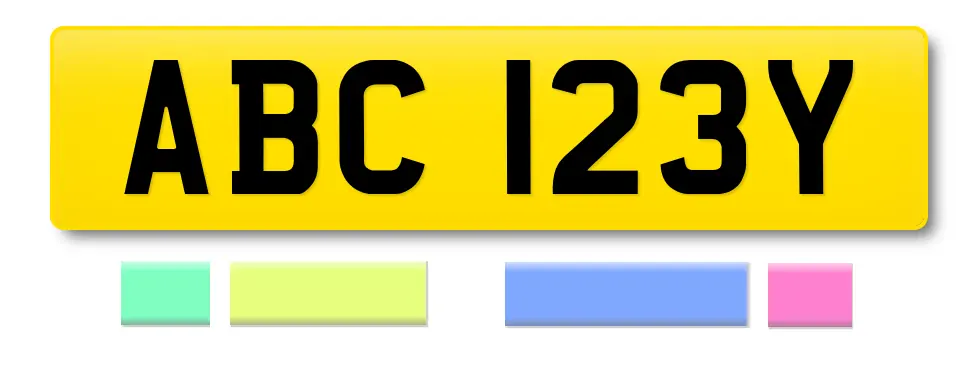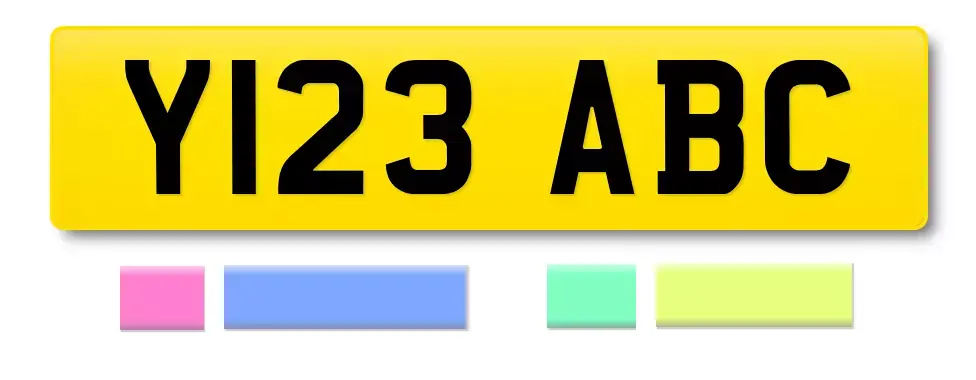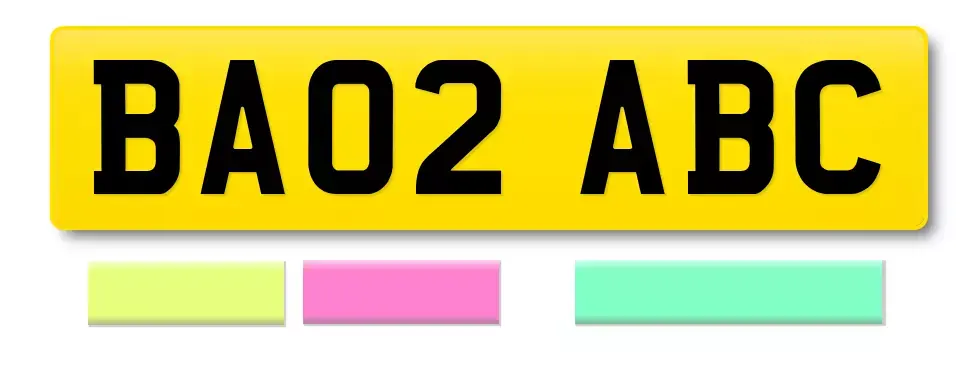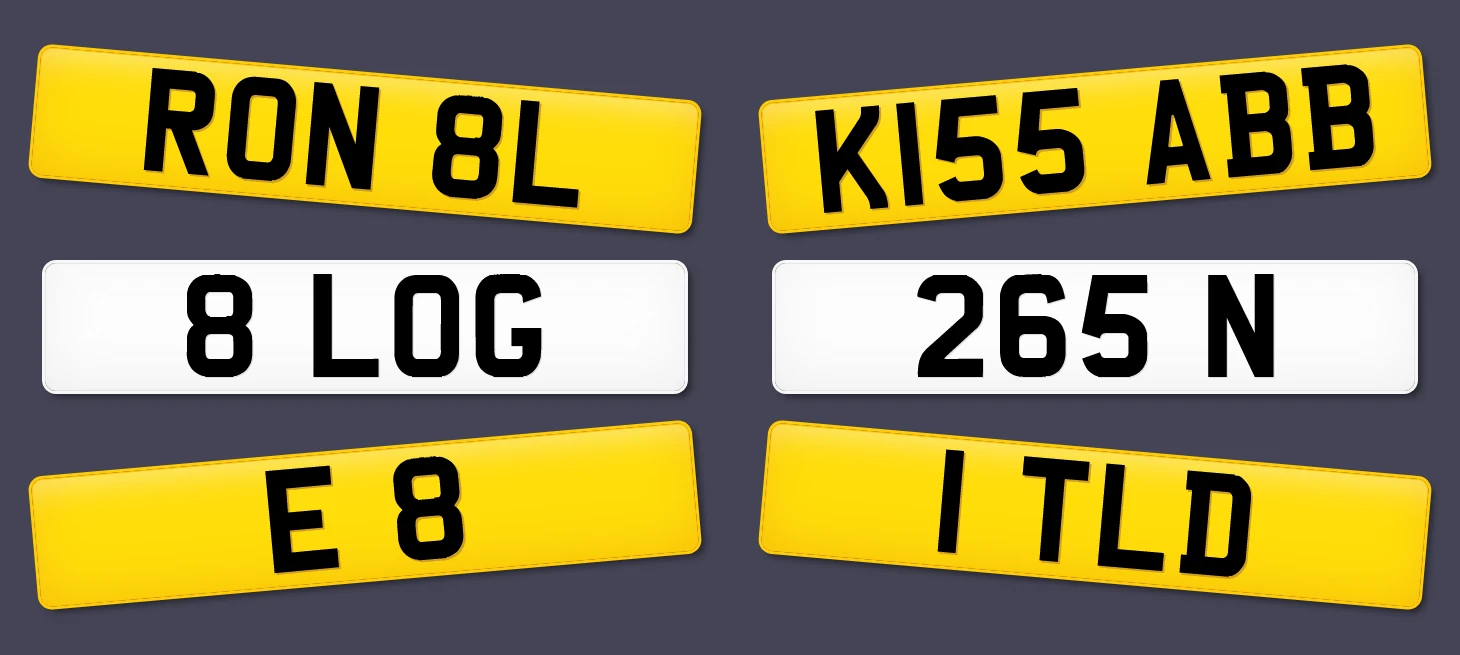
Throughout the history of the motor car, owners have recognised their prized vehicles as an extension of their image. And their surrounding communities have not been slow to nod in agreement.
Today, the market for private, personalised registration plates is positively buzzing. But if you want to dabble in the market, it's vital to know your number plate formats. Knowing your number plate formats enables you to assess whether or not a registration is valid. And if you can do that, you're well on your way to becoming a serious plate guru.
Before we get started on our thorough voyage through number plate formats, we should perhaps clarify that all personalised UK registration plates legitimately visible on our roads have a valid format, which has been sanctioned, at one time or another, by the Government.
What some people don't realise, is that many of the most desirable plates are effectively secondhand, and can be bought today on the private market through a private number plate dealer. The value of such plates has often dramatically outstripped the value of the vehicles from which they were taken. Imagine possessing a 1961 Morris Minor with a market value of £2,000, but a registration that's worth £40,000. In fact, a premium reg plate can actually double the value of even a beautiful Rolls Royce! That's how vibrant a market reg plates have become.
Naturally, if you're searching for a private, personalised number plate, you'll want to know which registrations can feasibly be purchased, and which ones can't. The formats govern whether or not it's possible to find the plate you really want. For example, ROB ERT is not a valid UK registration, so you'd never be able to buy it for legitimate allocation to a UK vehicle. You could, however, feasibly get the nifty lookalike ROB 32T, because that's a valid UK reg in the suffix format. The suffix format is old, but private trading has preserved its relevance. And it's one of the stops in the tour we're about to begin, so don't worry - if you don't already, you'll soon know all about it.
Let's dive straight into the formats, with explanations and pictorial representations. We're only covering the UK mainland formats in this post. We'll be enthusiastically looking at Northern Irish plates in due course:
HOW THE UK NUMBER PLATE FORMATS ARE COMPOSED
Before we go through the individual plate formats, there's a universal characteristic which applies to all UK number plates. No number plate issued in the UK can contain a letter Q. There will be more letters to add to that as we go through the different formats, so look out for those.
THE DATELESS PLATE FORMAT (1903 to 1962)
We begin our journey through the historical realm of number plates back in the very early 20th century. The year was 1903, and the type of plate introduced that year had no particular definition. It was, simply, a vehicle registration plate, and the very first example carried the character combo "A 1". Subsequently this plate and all of its direct descendants, came to be known as "dateless". That's because they contain no character or number sequence that denotes their year of issue.
So how do you recognise a dateless plate? Well, provided it's legally spaced, recognising a dateless registration is easy:
- There's a space in or towards the middle.
- On one side of the space, you see only letters (or a letter).
- On the other side of the space, you see only numbers (or a number).
That's the dateless ID. A letters-only block, then a numbers-only block. Or vice versa - numbers only, followed by letters only. As long as you remember that neither of the two character blocks in a dateless reg contains a mix of letters and numbers, you have a reliable means of identification.
As a double check, it's worth bearing in mind that a dateless plate could only contain a maximum of six characters plus a space. If you see a UK plate with seven characters (not including the space), it can't be dateless.
Let's start with some simple examples of dateless plates:
 |
 |
 |
 |
 |
 |
Notice how, even though the character blocks are of different lengths, and either the letter block or the number block can appear first, you never see both letters and numbers in any single block. That's how you confirm the plates are dateless. In the above examples, the blocks are symmetrical, with an even number of characters on each side of the space. But that won't necessarily be the case. Let's see some more examples of dateless plates. These are more interesting - especially bearing in mind that the maximum number of characters in a dateless plate (not including the space) is six:
 |
 |
 |
Okay, so in the above examples, we still have the dateless characteristic of only numbers or only letters on any one side of the space. But only one of the registrations is now symmetrical. The first reg has one letter before its space, but four numeric characters after its space. The second reg isn't symmetrical either. It has two letters, then four numeric characters. This brings us onto the subject of how the six-character sequence worked on these old plates.
All of the above dateless registrations have their letter block positioned first. This was the earliest format for dateless plates. It wasn't until the 1950s, when the availability of unused letterblock-first registrations ran low, that the format was reversed. The numbers then began to appear first. And even though there were still only six characters available in the reversed format, it lasted a much shorter time. Why? Because a lot more people were buying cars.
Observant readers (and number plate fans tend to be very observant) will deduce that the reg AB 1250 above contains the maximum number of characters. There are four number characters, but only two letters. And that introduces another rule in dateless plates:
If a dateless plate contains four numeric characters, its letters block can be no more than two characters in length.
Here are some format examples from the later, numbers-first series of dateless plates:
 |
 |
 |
Notice in the above examples, that in the third dateless plate, the logical sequence can't be completed. The logical 9999 ABC is prohibited by the six character limit. So when the numbers block stretches to four digits, the letters block can only accommodate AB - not ABC.
With dateless plates, the block of digits would run from 1 to 9999. So, from a single digit up to four. The letters block could always contain one character, or two characters. But the letters block in a dateless reg could only contain three characters if the block of digits did not contain four numeric characters.
Finally, a dateless plate issued on the UK mainland would never contain either a letter I or a letter Z. Both of these letters were reserved for Northern Irish plates. And to this day these two letters remain a good way to distinguish Irish plates from those issued on the UK mainland.
Let's have a bit of fun here, and see if you can determine which of the following plates is not a valid dateless reg, and why?
 |
 |
 |
Did you get it? The last of the three examples is not a dateless plate, because the block after the space contains a mix: one letter and one number. That can't happen in the dateless format. And in fact, that final plate is not valid within any of the UK formats. You'll see why if you read on. Note also that in the reg 1 LUV, it's easy to confuse the 1 with an I. It can appear that that particular plate is all letters. Number plate gurus often have to visualise the 1 or I character in both guises, in order to verify whether or not a plate can be valid.
THE SUFFIX PLATE FORMAT (1963 to 1983)
When the reversed series of dateless registrations reached the end of the road in late 1962, a completely new concept was introduced. The new number plate format would achieve a number of important goals:
- Increase the maximum number of characters to seven plus a space, thus enabling a much larger number of vehicles to be registered before the format reached the end of its life.
- Designate one character to the recognition of the year. At a glance, it would be possible to tell when the registration was issued.
- Make the format more rigid, understandable, and easier to administer.
Because the letter recognising the year would always appear at the end of the registration, the new format eventually became known as the "suffix" format. The year-designating letter would always be appended as a suffix to the rest of the reg.
So, how does the full suffix plate format work? A suffix plate has:
- Three letter characters, followed by a space, followed by either one, two or three numeric characters, and finally the year-designating suffix letter.
There would be no space between the number block and the suffix letter. Here are some examples of suffix registrations:
 |
 |
 |
 |
 |
 |
You can see that the character block before the space always had three letters. The first letter was always random. The second and third letters were always an area code. After the space, there would be a number ranging from 1 to 999, plus the the year identifier. In the first three examples above, the year identifier is A, which represents 1963. This letter evolved (almost) alphabetically as the years passed. The Y that denotes the year in the second three examples above, represents the final year of the suffix series: August 1982 to July 1983.
If you've been taking notes up until now, you'll already know why the year identifier sequence never reached Z.
I, Q and Z could not be used in a UK mainlain registration. But suffix plates brought an extra twist on those exclusions. Whilst the initial block of three letters only excluded I, Q and Z, the year designator suffix (always the letter at the end) also excluded the letters O and U. So, for example, you could feasibly get these suffix plates (all of which include either O or U):
 |
 |
 |
You could not feasibly get these:
 |
 |
 |
That's because neither O nor U could appear in the final character - the year suffix.
Let's finish the suffix format section with another question. Which of the plates below is not a valid suffix reg?
 |
 |
 |
This time, two of the registrations were not valid suffix plates. The first example was a true suffix reg. The second was not a suffix reg because there are numbers in the character block before the space, and there are no numbers in the block after the space. However, the second example is in fact a valid prefix plate - format coming up next. The final example is not a valid suffix plate for two reasons:
- It contains a letter I.
- It contains a letter Z.
THE PREFIX PLATE FORMAT (1983 to 2001)
Like the dateless format before it, the suffix format eventually ran out of steam. By 1983 there were no more letters available to designate the year. At that point, we saw a repeat of what had happened with the dateless format in the 1950s, and the prefix format was reversed.
Because, in the new series beginning in 1983, the year-designator letter would now be at the beginning of the reg, releases in this format came to be known as prefix plates.
And prefixes really were a straight reversal on the suffixes that went before them. A single-letter year designator, immediately followed by one to three digits. Then the space, and then a block of three letters. In the final block of three letters, the first letter was allocated at random, and the final two were the area code.
Here are some examples of prefix plates:
 |
 |
 |
Again, whilst the numeric portion of the plate varies from one to three in its number of digits, the three-letter block stays rigid, and the year prefix is always there.
Because you're now getting well-versed in how the plate formats work, and a simple reversal of the suffix plate doesn't need much explaining, let's pitch into our customary mini-questionnaire straight away. Why are the following three examples NOT prefix plates?
 |
 |
 |
The first plate is not a prefix, because it has two letters before the numbers begin in the first block. It's actually a current-style reg, which was the series that came after the prefix plates, and which is still running today. The second example contains the letter I, which excludes it from being a prefix plate. And the third plate is not valid in any format (no format has ever comprised four consecutive letters). But to work as a prefix reg, the final plate would have to begin with a letter.
THE NEW-STYLE, OR CURRENT STYLE FORMAT (2001 TO PRESENT)
The final UK mainland format - known as the current- or new-style, is the easiest to identify, because it always begins with a block containing two letter characters and two numeric digits. That means you only have to look in one place, and you can say with certainty that you're looking at a new-style plate. The vast majority of plates on today's roads are in this format.
Here's how a current plate is laid out:
A single block containing two letters then two numbers. Then a space, then three letters.
Unlike any other plate format before it, a current plate always contains seven characters plus the space.
The first two letters are the geographical identifier. The two digits after the geo-ID represent the year. And the three letters after the space are random.
In a break with UK mainland tradition, the letter Z was permitted for use in new-style registrations, but not in the first two letters - which constitute the geographical code. The letter Z could only appear in the second character block of three random letters. I and Q were still full-on excluded.
Here are some examples of current-style reg plates:
 |
 |
 |
It's apparent that the character formation never varies, and out on the roads we're so used to seeing one new-style plate after another, that other formats tend to stand out in a glance test.
Because of the volume of vehicles being registered, the year code in a new-style plate had to be run in two parts. From March to August in any year, the year code would be the last two digits of the actual year. So:
- BX02 ABC represents 2002.
- BX09 ABC represents 2009.
- BX16 ABC represents 2016.
From September of one year through February of the next, the year code will be the last two digits of the actual year, plus 50. So:
- BX52 ABC is from 2002-2003.
- BX59 ABC is from 2009-2010.
- BX66 ABC is from 2016-2017.
Most people know the new-style format pretty well. It's the older formats that tend to cause more confusion.
A QUICK PICTORIAL SUMMARY OF THE COMPOSITION OF UK MAINLAND REG PLATES - AND THE MEANINGS OF THE CHARACTERS
The pictorial summary below gives an overview of the four primary UK mainland plate types, and in particular, what the different characters and character blocks represent.
We've colour-coded the features of the different number plate formats below. Here's your key...
- Year identifier.
- Random letters.
- Random numbers.
- Geo identifier.
NUMBER PLATE FORMATS AS DESIRABLES
DATELESS PLATES IN CULTURE AND COMMUNITY
Today, the highly cherished dateless number plates are broadly regarded as the cream of UK stock. They're a staple choice for very high-profile celebrities and stars. For example, AMS 1 is very famously associated with Lord Sugar.
And even in the age when "dateless" plates were current, it was clear to motor manufacturers that cars were far more than just marvels of engineering. If we timehopped back more than a century to the summer of 1922, we'd find ourselves amid the early promotional phase for the then jawdroppingly futuristic Austin Seven. But when a prototype Seven was turned out for its publicity shots, it was not merely plonked onto a forecourt or spotlit in a showroom. It was photographed out in the local community as a facet of daily life.
In Northfield, the south Birmingham suburb adjacent to the car's Longbridge birthplace, a lavishly-dressed and elaborately-behatted lady sat at the Austin Seven's steering wheel outside a popular retail store of the day. The shopkeeper - himself immaculately presented - stacked carefully-wrapped goods into the lady's vehicle as a photographer's shutter clicked. This would not be a promo for the engineering fanatic. This would be a promo for the high fashionista. Cars and kudos have been inextricably linked ever since.
The following decade saw an almost inevitable birth of private designations for registration plates. But it would be the 1960s when advancements in vehicle styling and a switch to a more 'hackable' number plate format really began to propel interest in personally-suited registrations. Public interest captured the imagination of the media and broadcasters, which in turn fuelled public interest all the more.
SUFFIX PLATES IN CULTURE AND COMMUNITY
The aforementioned change in number plate format was the switch, in 1963, to what we now call the "suffix" registration.
The UK suffix number plate system was primarily designed to provide a straightforward method for identifying the year a vehicle was registered. But those who were seeking to personalise and customise their plates found the suffix format exciting, because placing a letter at the end of the numbers block for the first time, accommodated a simulation of longer first names. For example, DAV 1D, which would read as a perfect DAV ID at a glance, had never been possible with dateless plates. Suffixes also allowed a more creative use of numbers, as in a reg such as the aforementioned ROB 32T. The T suffix at the end encloses the 3 and the 2 in such a way that the reg is read as ROB ERT at a glance.
The suffix format was the first to really awaken the creativity of the public, and bring approximations of people's full first names onto the roads.
The the nostalgia factor is frequently overlooked when it comes to vintage registrations. And when they're seen reformatted into contemporary white-backed and yellow-backed style, with the current Charles Wright 2001 font, it's easy to see why. The physical plates may be new, but the registrations they feature are many decades old. Even some of the less "personal" registrations with an old suffix format can have nostalgic appeal to people who recall seeing them as a regular part of day-to-day culture.
Suffix plates have also found their way into celeb culture, and have featured on the vehicles of major stars. For instance, the suffix plate "COM 1C" has become synonymous with the comedian Jimmy Tarbuck.
The year letter in the suffix system reached the end of the alphabet in 1983, heralding another new format...
PREFIX PLATES IN CULTURE AND COMMUNITY
The prefix registration series was inagurated at a time when the private plate craze as we know it today was just getting into its stride.
1983 was famous for many things: The introduction of the pound coin, consumer adoption of the compact disc, and of course the birth of the "bad hair day". But number plate fanatics know 1983 best for the introduction of the prefix registration system.
Prefix plate "K1 NGS" is noted as one of the most valuable in the series, and its high profile shows us that even plates from a series that overlaps into the 21st century can become star purchases. But another interesting prefix plate in celebrity possession is V12 APE. This piece of showbiz culture resides on the Ferrari F12 TDF driven by one Hugh Grant.
The prefix registration's reversal of the suffix format provided a wealth of new opportunities to simulate full first names. Combinations such as J4 NET and J3 RRY suddenly became possible, and the growing private plate market responded with increasing enthusiasm.
It's an enthusiasm that has only continued to increase over time.
CURRENT-STYLE PLATES IN CULTURE AND COMMUNITY
Which brings us to our new style plates. The authorities learned a lesson from suffix and prefix registration systems, and in the next number plate era there would be a longer-lasting format.
Whilst the format itself would be more predictable, having a previously unprecedented five letters in the reg would once again give creative observers a proverbial field day. For example, in the first character block alone one could create words such as FREE (FR33) or BOSS (BO55). And there's then a full three letters left to have fun with.
So current-style, or new-style number plates in the UK do have collector appeal, although not typically to the same extent as some older formats like the dateless or suffix plates.
In the era of the current-style plate, there's been an almost fever-pitch clamour for personlised number plates, which has driven the value of some plates skyward.
NOW YOU KNOW
Whether you're looking for a bargain, or you're a big spender with very specific plate parameters in mind, one of the best places to start is on the NetPlates search page, where you'll find our search facility, with access to tens of millions of plate options. As you search, you'll see plates divided into blocks of dateless, suffix and prefix. And you'll doubtless also notice new-style plates in the results. Try it out with some search terms of your choice, and see if you can find your perfect plate in one of the formats we've seen on our journey.


